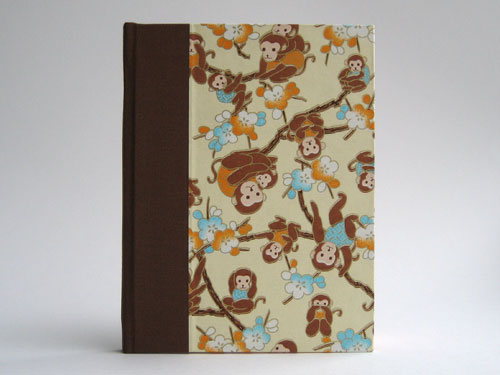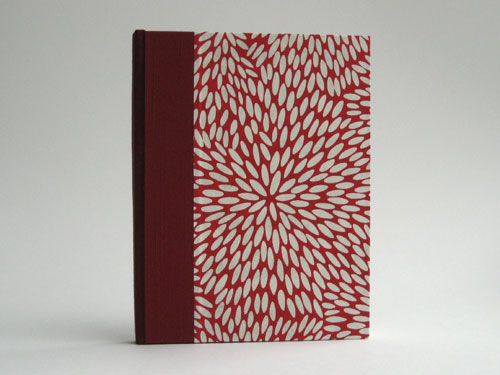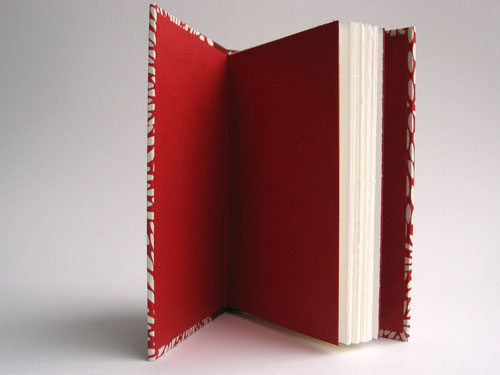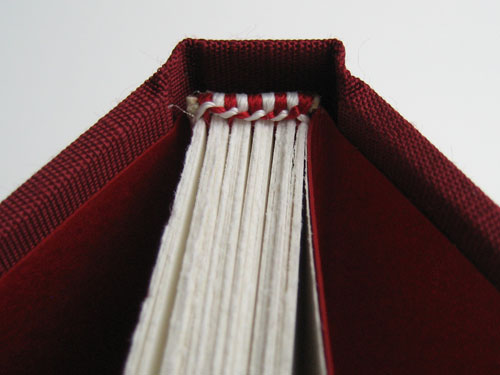Case-Bound Books Series – Book II
November 2nd, 2009 | Link

Monkey paper!

Orange endsheets add to the fun!

And a close up of the endbands. I would have gone for orange here too, except that when I bought my spools of silk thread I only bought a half-dozen colors that I thought I’d use, and oddly enough orange wasn’t among them. So I went for the safe colors here.
¶ Posted in
Paper | Tags:
bookbinding |
Comments Off on Case-Bound Books Series – Book II
Case-Bound Books Series – Book I
October 31st, 2009 | Link

I’ve been slowly working through all the paper and boards I’ve prepped over the last few months, and the stack of completed Coptics and accordion photo albums has grown and grown. But I also made some case-bound journals that I was pretty happy with, in two sizes, and I thought I’d post pics of those, because I don’t do them often and because I hand-sewed the endbands on them and I’m kind of proud of myself.

I did two sizes, and this is one of the smaller ones at 4-5/8″ wide by 5-7/8″ high, with 192 pages of soft white 24lb Mohawk Superfine paper (8 sections of 6 folios, sewn onto tapes).

Here’s a close-up of the headband: it’s a simple beaded headband from Headbands : How to Work Them by Jane Greenfield and Jenny Hille. I took a class at the San Francisco Center for the Book a few months ago where they taught the same method, but I’d forgotten how to do it by the time I actually got around to sewing one, so I was happy to have this book. The drawings are pretty clear.
Long Stitch with Tie Flap
August 31st, 2009 | Link

Still playing with the long stitch book structure. This one is similar to the flapped closure I did in May, but with a ribbon tie instead of the button-and-string closure.

I can’t remember where I bought this ribbon, but I’ve wanted to do something like this with it for a while. It’s a matte cotton ribbon with a loose weave, so it has a bit of a rough texture to it.

I like the black cotton paired with the very smooth, blue-gray card stock. But I think I like the button tie closure more: maybe because the closure doesn’t extrude beyond the edges of the book on the button tie closure, or because the closure thread on that version echoes the thread used in the spine sewing.
I like simple things.
¶ Posted in
Paper | Tags:
bookbinding |
Comments Off on Long Stitch with Tie Flap
And a I and a II and a…
August 28th, 2009 | Link

I was so happy with II that I decided to turn it into a set.

I uses the same handmade Lokta bark paper from Nepal as II. Aside from the reversal of colors, and the difference in the cut-out, it is constructed in the same way.

The sewing is, again, the Long Stitch Through Slotted Wrapper Cover, from Keith Smith’s Non-Adhesive Binding I: Books Without Paste or Glue. It’s a slightly wonky sewing, what with the offset and the leaning threads at the top and bottom, and often I like a little more symmetry but here I find its lack rather suits the handmade feel.
I have a number of colors of the Lokta paper. I think it would be neat to make a whole set of these, with a slip case to hold them all, so that the different colored spines would be showing with the stitching. Though I’m not sure I’m interested enough by the idea to venture into box making (I’ve made one box and it turned out okay, but it doesn’t excite me.)
Gocco Geraniums, or, Sorry Jane, I Can’t Keep a Secret
August 26th, 2009 | Link

I wanted a little extra gift to send to Jane when she and Patrick get home from their wedding (see the guest book post earlier this month). Since she liked the geranium paper, and her wedding shoes are green, I wanted to make note cards that matched the theme. But I can’t draw, I really can’t, so I traced one of the geraniums from the guest book paper and used that for the note card. I’m quite happy with the result, and the color is about perfect with the Moss envelopes from Paper Source.
Since Gocco is all about the multiples, I not only had enough cards for Jane, but for myself as well. And since I had a few challenges getting the full bleed to work (getting ink off the edges of the paper), I cut some of the splotchy ones up into gift tags.

I made a number of book blocks this weekend by sewing sections onto tapes, and I saved all the short bits of linen thread that are left at the end of the sewing to use as ties for the tags.
¶ Posted in
Paper | Tags:
gocco |
4 Comments »
II: Long Stitch Through Slotted Wrapper Cover
August 25th, 2009 | Link

I’ve done a fair bit in the studio recently, but almost all of it is prep work for books yet to be finished: the boards are cut and the sections laid out, punched and/or sewn onto tapes, all in preparation for a bunch of books-to-be, but there is not much interesting to show you. I like to do this sometimes, get all the production work out of the way, or enjoy the meditative repetition of tearing down paper sheets or sewing sections onto linen tapes. But then sometimes I want something to be done.

The cover for II is handmade Lokta bark paper from Nepal, which I purchased from Hollander’s. It’s made from two pieces: the off-white piece is folded over the red one, so the cover is three layers thick and the cut-outs show the red underneath. The covers and pages are all secured in place by the sewing, so this is a true non-adhesive book.

The sewing is from Keith Smith’s Non-Adhesive Binding I: Books Without Paste or Glue.

l like the simplicity of this little book (only 4-1/2″ wide by 5-3/4″ high by 1/4″ thick). The texture of the paper makes it pleasurable to hold and, along with the contrast of the stitching and the strong graphic cut-outs, interesting to look at. The cover is delicate (this is not a book to be tossed in a bag) but still solid enough to provide structure. I often forget about these paper-covered books, but I come back to them again and again. I think there are 10 more of them in my near future.
¶ Posted in
Paper | Tags:
bookbinding |
Comments Off on II: Long Stitch Through Slotted Wrapper Cover
Woven Chain Guest Book
August 5th, 2009 | Link

I’m unabashedly pleased with myself on this guest book, which is a wedding gift for Jane and Patrick.

There are three sections of Rives BFK cover-weight paper totalling 24 sheets. The sections are attached to the spine using the Woven Chain sewing from the second volume of Keith Smith’s non-adhesive binding series, 1- 2- & 3-Section Sewings, and 12/3 waxed linen thread. There’s 1/4″ between the first and second sewing stations at the top, and 3/4″ between the remaining sewing stations. There are a couple of reasons why I like this sewing (in spite of the agony of punching all those holes): it’s attractive on the outside, and it has good structural integrity because thread runs all the way down inside each sections.

Finished size is 11-5/8″ wide by 7-3/4″ high by 1-3/8″ deep. Jane picked out the lovely geranium Japanese paper from The Paper Place. The book cloth is Asahi book cloth from Talas.
Adventures in Sewing from Japanese Patterns
July 3rd, 2009 | Link

Recently I’ve been inspired to try sewing from Japanese pattern books. I purchased some books from Pomadour24’s Craft Café on Etsy and was very happy with the experience—the books arrived from Japan in about a week. There are several stores on Etsy that sell them, and in most cases the sellers have photographed or scanned pages from the books so that you can see what the patterns look like. I’ve also been reading Japan Couture Addicts, a French blog by Japanese sewing fans who post their creations. It’s a little weird to be reading in French about Japanese patterns, and I only get about half of it (I studied French for 10 years at school, but haven’t had much occasion to use it in the 25-odd years since), but it’s interesting to see how the finished garments look on different body types, and to see how people have modified the patterns. A couple of times I’ve dismissed a pattern at first look, then seen how someone else had made it up and fallen in love with it.
If you’ve done basic garment sewing, it’s not hard to follow the patterns. The biggest challenge is usually finding and tracing all the pattern pieces from the giant piece of paper that accompanies the book. Once you’ve traced the pieces, you also have to add in the seam allowances, which I was struggling with a bit—straight lines are easy, but curves were a bit of a pain until I discovered this brilliant tip of using the sewing machine. I also found a lot of useful information from this series on sewing from Japanese craft books and from this list of translations.

So far I’ve made a couple of summer tops and a skirt (sorry, not the best photo of the skirt—it was really windy that day), and the muslin for a dress that I might sew up with what’s left of this long weekend. There will probably be quite a few more postings on this subject in the weeks to come.
¶ Posted in
Cloth | Tags:
japanese,
sewing |
Comments Off on Adventures in Sewing from Japanese Patterns
A Book About the Books
June 21st, 2009 | Link
Moving from a production mindset to an experiential mindset in bookbinding has inspired me to record more information about the books while making them. Previously, I photographed a book when I completed it, and perhaps blogged or posted the picture to my Bookbinding set on Flickr along with few notes about the size and number of pages, and then moved on. If it was a book I was likely to make multiples of and didn’t change much from one to the next—such as a photo album or journal from a purchased book block—I might record the sizes to cut for the boards, cover paper and book cloth in the (purchased!) notebook I stick in the box with my binding tools, but that was it. So I’ve started to catalog the books as I work on them.
I bought a wire-bound sketch book for this project, because I wanted the freedom to rip out pages if needed, and to be able to paste in photographs of the book and samples of paper and book cloth. The format for each entry is something like this:
- Catalog number and title
- Finished size and number of pages
- Description
- Cover: board or cover stock, thickness or weight, measurements of cover and spine pieces, samples of decorative paper, book cloth, paste-down, etc., and place of purchase
- Pages: paper used, weight, full-sheet size, place of purchase, folio size, number of folios per section, number of sections, and a sample
- Sewing: thread used, location of sewing stations, method, and a sample
- Notes on construction: information I found useful in the construction of the book, such as reference books/pages for instruction; any details such as the size of the bit I used to drill holes; what I think went well or poorly; what I’m happy with or not happy with; etc.
- Date completed
- Name of the recipient, if I didn’t keep it
- Sketches and/or photographs
So far there are four entries in my Book About the Books, and I already wish I’d done this two years ago.
What about you other bookbinders out there? Do you keep a catalog or journal of your books as you work on them? What other information do you find helpful when you’re looking back over your works? What do you do?
Duck, Duck, Duck
June 9th, 2009 | Link

I realized recently that I no longer have the patience for large knitting projects. My Chicknits Ribby Cardi has been languishing unfinished for months now—it’s nearly done, I just need to pick up the neck stitches and sew in the ends and the zipper, but I haven’t been able to face it. Instead, I’ve turned to small projects with minimal finishing and quick gratification. Like neck warmers.
I’m in love with this whole concept of neck warmers. I’m always cold, and it seems like part of that is if my neck gets cold the rest of me follows. Neck warmers don’t hang in the way or get caught in the office chair like scarves can. And since they don’t usually flop around to expose the back side of the knitting, you can play with a lot of different stitches.
This piece is based on the Holding Hands, Feeding Ducks pattern from A Time to Knit blog; I found it through my network on Ravelry. Like the Herringbone Cowl I finished a couple of weeks ago, this one is Malabrigo Silky Merino yarn. The mother-of-pearl buttons came from Britex. (Kudos to the clerk who was able to decipher my vague description of the buttons I’d purchased for the Luna Capelet and pull up the same box!)

You can see how easy it would be to pick a favorite stitch from the Barbara Walker Treasury of Knitting Patterns and throw one of these together in a day or two.
¶ Posted in
Yarn | Tags:
knitting |
Comments Off on Duck, Duck, Duck





























